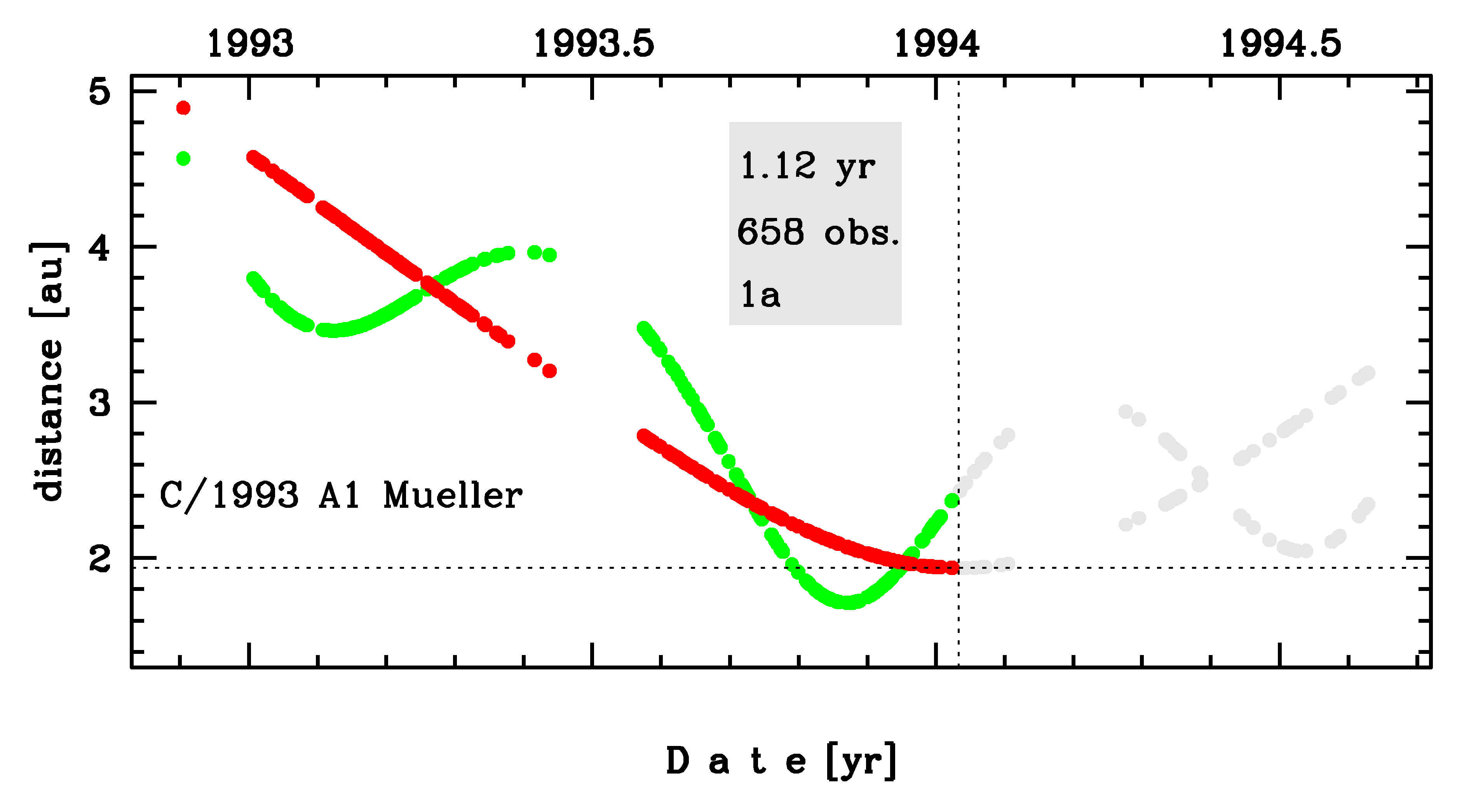C/1993 A1 Mueller
more info
Comet C/1993 A1 was discovered on 2 January 1993 by Jean Mueller (Palomar Sky Survey II). Later, a prediscovery image of this comet taken on 26 November 1992 (Catalina Station, Tucson) was found.At the moment of discovery, this comet was a year before its perihelion passage and it was last observed in the mid-August 1994.
Comet had its closest approach to the Earth on 13 November 1993 (1.713 au), 2 months before its perihelion passage.
This is a comet with nongravitational effects strongly manifested in positional data fitting.
Preferred solution given here is based on data spanning over 1.72 yr in a range of heliocentric distances: 4.89 au – 1.94 au (perihelion) – 3.19 au.
This Oort spike comet suffers moderate planetary perturbations during its passage through the planetary system; these perturbations lead to escape the comet on hyperbolic orbit from the planetary zone.See also Królikowska 2020.
Comet had its closest approach to the Earth on 13 November 1993 (1.713 au), 2 months before its perihelion passage.
This is a comet with nongravitational effects strongly manifested in positional data fitting.
Preferred solution given here is based on data spanning over 1.72 yr in a range of heliocentric distances: 4.89 au – 1.94 au (perihelion) – 3.19 au.
This Oort spike comet suffers moderate planetary perturbations during its passage through the planetary system; these perturbations lead to escape the comet on hyperbolic orbit from the planetary zone.See also Królikowska 2020.
| solution description | ||
|---|---|---|
| number of observations | 658 | |
| data interval | 1992 11 26 – 1994 01 08 | |
| data arc selection | data generally limited to pre-perihelion (PRE) | |
| range of heliocentric distances | 4.89 au – 1.94au | |
| type of model of motion | NC - non-gravitational orbits for symmetric CO-g(r)-like function | |
| data weighting | YES | |
| number of residuals | 1306 | |
| RMS [arcseconds] | 1.15 | |
| orbit quality class | 1a | |
| previous orbit statistics, both Galactic and stellar perturbations were taken into account | ||
|---|---|---|
| no. of returning VCs in the swarm | 25 | |
| no. of escaping VCs in the swarm | 4976 | |
| no. of hyperbolas among escaping VCs in the swarm | 4105 | * |
| previous reciprocal semi-major axis [10-6 au-1] | -23.30 – -9.34 – 3.69 | |
| previous perihelion distance [au] | 6.8 – 8.6 – 12 | |
| previous aphelion distance [103 au] | 160 – 440 – 3100 | |
| synchronous stop epoch [Myr] | -1.94 | S |
| percentage of VCs with qprev < 10 | 76 | |
| percentage of VCs with 10 < qprev < 20 | 24 | |
| previous orbit statistics, here only the Galactic tide has been included | ||
|---|---|---|
| no. of returning VCs in the swarm | 40 | |
| no. of escaping VCs in the swarm | 4961 | |
| no. of hyperbolas among escaping VCs in the swarm | 4076 | * |
| previous reciprocal semi-major axis [10-6 au-1] | -22.68 – -9.00 – 3.88 | |
| previous perihelion distance [au] | 5.8 – 6.9 – 8.2 | |
| previous aphelion distance [103 au] | 160 – 450 – 2900 | |
| synchronous stop epoch [Myr] | -1.99 | S |
| percentage of VCs with qprev < 10 | 100 | |
